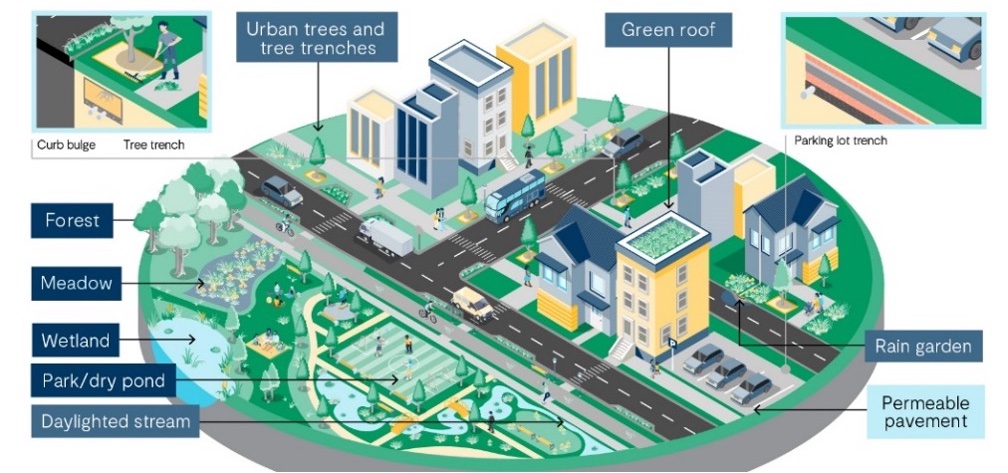
Governance for green infrastructure
December 8, 2023
By Jennifer Court, Gemma Dunn and Jeff Matthews
If managed properly, GI assets can play an important role in increasing resilience.
Municipalities across Canada are facing challenges with growing populations, aging infrastructure, degraded ecosystems and the need for climate change mitigation and adaptation, slow economic growth and low social equity. Increasingly, they are turning to green infrastructure (GI) to help address these challenges, given its low cost and wide range of economic, environmental, health and social benefits (see Figure 1).
GI includes natural assets (e.g. native vegetation, wetlands and parks), enhanced/hybrid assets (e.g. green roofs, bioswales and raingardens) and engineered assets (e.g. permeable pavement, perforated pipes, infiltration trenches and cisterns). If managed appropriately, these assets can play an important role in increasing the resilience of a city (see Figure 2).
Unique challenges
As GI assets represent a unique combination of engineered and living elements, they present a number of challenges in themselves:
- Natural elements (e.g. plant or soil systems) need different maintenance to function optimally compared to water-related infrastructure.
- Many decision makers do not recognize GI as municipal infrastructure and, as a result, do not include its full range of benefits among financial priorities.
- GI assets have traditionally been owned and maintained by separate municipal departments, so the scope of governance—including responsibility and accountability for associated maintenance—is unclear.
Financing, governing, monitoring and maintaining GI assets is already complex, but will only become more so as local governments become responsible for increasingly larger portfolios of them. Hence, there is a need for more rigorous, well-considered and effective asset management, to ensure assets are not built and then forgotten.
The importance of asset management
GHD recently demonstrated the relationship between asset management and governance when it completed a GI planning project for the City of Vancouver. The program provides guidance for managing existing GI, scaling up implementation of new assets and adapting to evolving governance and funding challenges. It focuses on maximizing the benefits of existing assets and ensuring the city realizes a return on investment (ROI).
Specifically, the program is in support of the goals articulated in Vancouver’s Rain City Strategy, with an aspirational vision of becoming a water-sensitive city and treating rainwater as a resource to be embraced and valued. The strategy aims to improve water quality, resilience, natural and urban ecosystems and overall livability.
GI comprises both engineered and living elements.
The city has set measurable targets by committing to capturing and cleaning a minimum of 90% of its average annual rainfall; managing urban rainwater runoff from 40% of its impervious areas by 2050; and retrofitting 10% of such surfaces, such that GI manages the runoff. To achieve these goals, the city forecasts it will need to significantly scale up GI assets from 283 to 10,000 by 2050.
GHD worked with the city to develop a ‘living framework’ for GI asset management framework—the first of its kind in Canada. This process, which involved gaining a greater level of understanding about existing GI (including associated life-cycle costs) and developing a plan that could be sustainably scaled up based on both financial and human capacity, was undertaken by asking five key questions:
- What is the current context?
- What needs to be delivered?
- How should we deliver it?
- Who is accountable for delivery?
- How do we pay for it?
This work also involved identifying pressures and demands that will affect the city’s services and determining how to track these services’ performance levels. This process included data reviews, financial modelling, interviews and workshops with both Vancouver employees and their peers from comparable cities.
The project’s outcomes included:
- A level of service (LoS) framework.
- A service delivery model (SDM), which outlines all organizational processes involved in the design, development, deployment and operation of GI services.
- A governance structure designed to complement existing municipal processes and relationships and support the success of future GI development.
- A GI asset valuation, including replacement, expansion and renewal costs and time horizons.
- Cost estimates associated with various growth strategies, providing insights on budgeting requirements and potential annual investment rates.
GI asset management is still an emerging practice.
An example to other municipalities
A key lesson learned from this process was GI asset management is still an emerging practice, particularly at the strategic level. While some municipalities are doing well at day-to-day operations and maintenance (O&M) of their GI, none has yet implemented asset management at the strategic decision-making level.
Adopting a strategic approach to GI asset management, which drives short-, medium- and long-term decision making, is crucial to addressing the aforementioned challenges and ensuring sustainable GI implementation.
Vancouver’s takeaways wile serve as examples for other municipalities of how to strategically plan, set targets for, fund and manage GI assets in a sustainable manner and fully realize the important benefits such assets deliver.
Jennifer Court is GI lead, Gemma Dunn is Western Canada water market leader and associate and Jeff Matthews is executive advisor for GHD. For more information, visit www.ghd.com.


